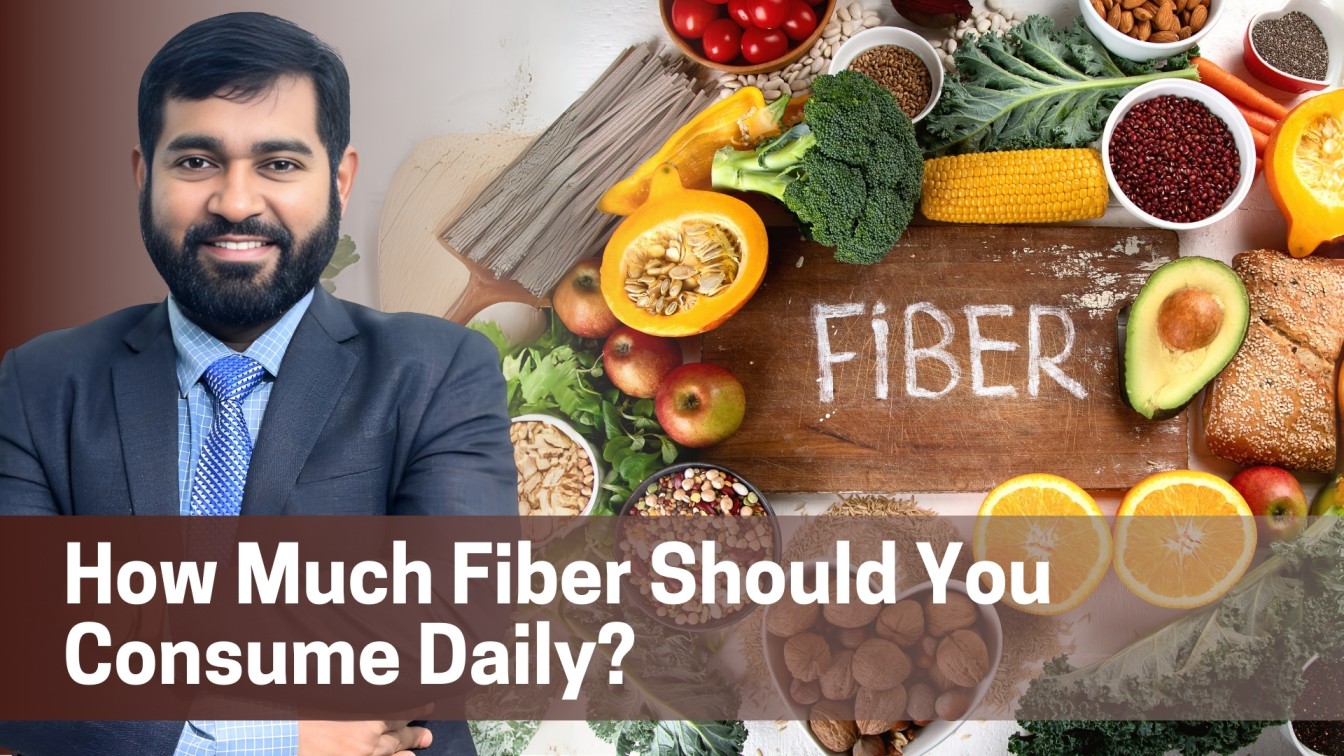27
How Much Fiber Should You Consume Daily?
Fiber is an essential part of a healthy diet, playing a crucial role in maintaining good digestive health, supporting heart health, and regulating blood sugar levels.
Fiber is found naturally in plant-based foods such as fruits, vegetables, whole grains, legumes, and nuts. Understanding how much fiber you should consume daily, as well as the benefits it provides, is key to incorporating it into your diet effectively.
Recommended Daily Fiber Intake
The recommended daily intake of fiber varies depending on age, gender, and individual health conditions. According to the Institute of Medicine (IOM), the daily fiber intake should be:
- Men:
- 38 grams per day for those aged 19-50
- 30 grams per day for men aged 51 and older
- Women:
- 25 grams per day for those aged 19-50
- 21 grams per day for women aged 51 and older
Pregnant and breastfeeding women may have different fiber requirements as well. The American Heart Association (AHA) emphasizes that most people should aim to get at least 25-30 grams of fiber each day from food sources, rather than supplements.
Types of Fiber
There are two main types of dietary fiber: soluble fiber and insoluble fiber. Both types offer unique health benefits, and a healthy diet should include both.
-
Soluble Fiber: Soluble fiber dissolves in water, forming a gel-like substance in the digestive system. It helps to lower cholesterol levels and stabilize blood sugar by slowing down the absorption of sugar in the bloodstream. This type of fiber is found in foods such as oats, barley, nuts, seeds, beans, lentils, apples, and citrus fruits.
-
Insoluble Fiber: Insoluble fiber does not dissolve in water. It adds bulk to the stool and helps food move more quickly through the stomach and intestines, which can prevent constipation and promote overall digestive health. This type of fiber is found in whole grains, wheat bran, and vegetables such as cauliflower, potatoes, and carrots.
Both types of fiber contribute to a balanced, healthy digestive system. Therefore, it's important to eat a variety of fiber-rich foods to reap the full range of benefits.
Health Benefits of Fiber
-
Digestive Health: One of the primary functions of fiber is supporting a healthy digestive system. Insoluble fiber helps prevent constipation by adding bulk to stool and facilitating its movement through the intestines. Soluble fiber, on the other hand, can help regulate bowel movements and prevent diarrhea by absorbing excess water.
-
Heart Health: Fiber has been shown to lower LDL (bad) cholesterol levels by binding to cholesterol particles in the digestive system and removing them from the body. This reduction in cholesterol can lower the risk of heart disease and stroke. The American Heart Association states that a diet rich in fiber from whole foods can help prevent heart disease and lower blood pressure.
-
Blood Sugar Regulation: Fiber can help regulate blood sugar levels, which is particularly beneficial for people with type 2 diabetes or those at risk of developing it. Soluble fiber, in particular, slows down the absorption of sugar in the blood, leading to more stable blood glucose levels. This may help prevent spikes and crashes in energy levels, which is important for those with diabetes.
-
Weight Management: High-fiber foods can help control appetite by promoting a feeling of fullness, which can reduce overall calorie intake. Fiber also slows down digestion, allowing you to feel satisfied for a longer period after eating. By including fiber-rich foods in your diet, you may be able to better manage your weight and prevent overeating.
-
Colon Health: A diet high in fiber, especially from fruits, vegetables, and whole grains, may reduce the risk of colorectal cancer. Fiber helps move waste through the colon more efficiently, which may lower the time harmful substances are in contact with the colon lining.
-
Gut Microbiome Health: The human gut microbiome benefits from a fiber-rich diet because fiber serves as a food source for beneficial bacteria. These bacteria help break down fiber and produce short-chain fatty acids (SCFAs), which promote a healthy colon and reduce inflammation.
How to Increase Fiber Intake
While fiber is essential for health, many people do not consume enough of it. According to the Centers for Disease Control and Prevention (CDC), only about 5% of Americans meet the daily recommended fiber intake. To ensure you're getting enough fiber, consider the following tips:
-
Eat More Whole Grains: Choose whole grains like brown rice, quinoa, whole wheat bread, and oatmeal instead of refined grains like white bread and pasta. Whole grains are packed with fiber and other essential nutrients.
-
Include More Fruits and Vegetables: Incorporate a variety of colorful fruits and vegetables into your meals. Aim to include fruits and vegetables with skins (like apples, pears, and berries) to increase your fiber intake.
-
Add Legumes: Beans, lentils, and peas are excellent sources of fiber and can be added to soups, salads, and stews. Legumes are not only high in fiber but also provide protein and other vital nutrients.
-
Snack on Nuts and Seeds: Almonds, chia seeds, flaxseeds, and sunflower seeds are all great sources of fiber. Try adding them to smoothies, yogurt, or salads for an easy fiber boost.
-
Opt for Fiber-Rich Breakfast Foods: Choose cereals with high fiber content, or add ground flaxseeds or chia seeds to your morning oatmeal or smoothie.
-
Read Food Labels: Many packaged foods provide fiber information on their labels. Look for foods that have at least 3 grams of fiber per serving.
Potential Side Effects of Too Much Fiber
Although fiber is essential for health, consuming too much fiber too quickly can lead to some digestive discomfort. The National Institutes of Health (NIH) notes that excessive fiber can cause bloating, gas, or cramping. To prevent these issues, it’s important to gradually increase fiber intake and drink plenty of water to help fiber move through the digestive system smoothly.
Conclusion
Fiber is a vital nutrient that supports digestive health, heart health, and blood sugar regulation, among other benefits. The daily recommended intake varies based on age and gender, but aiming for 25-38 grams per day is a good guideline for most adults. A diet rich in fruits, vegetables, whole grains, legumes, and nuts can help you meet these recommendations and promote overall health. If you're not getting enough fiber, try incorporating more fiber-rich foods into your meals gradually. However, it’s important to do so slowly to avoid digestive discomfort.
Here are 15 links related to daily fiber intake, its importance, and tips for increasing fiber consumption:
-
"How Much Fiber Should You Consume Daily?" - Verywell Fit This article discusses how much fiber you should be consuming, how it benefits your health, and offers tips on getting enough fiber in your diet. Link: https://www.verywellfit.com/how-much-fiber-should-you-consume-daily-5183293
-
"The Benefits of Eating Fiber" - WebMD This page outlines the health benefits of fiber, including digestive health, heart health, and weight management. Link: https://www.webmd.com/diet/obesity/ss/slideshow-fiber
-
"What is Fiber and How Much Do You Need?" - Mayo Clinic Learn about the types of fiber and the role they play in your digestive health and overall wellness. Link: https://www.mayoclinic.org/healthy-lifestyle/nutrition-and-healthy-eating/expert-answers/fiber/faq-20422525
-
"How to Increase Fiber in Your Diet" - Healthline A practical guide for adding more fiber to your diet with tips on fiber-rich foods and how to increase your intake safely. Link: https://www.healthline.com/nutrition/how-to-increase-fiber-intake
-
"High Fiber Foods That Help You Lose Weight" - Eat This, Not That Focuses on fiber-rich foods that can help you feel fuller and assist in weight loss. Link: https://www.eatthis.com/high-fiber-foods-for-weight-loss/
-
"Are You Getting Enough Fiber?" - Verywell Health An in-depth article on the importance of fiber in your diet and how much fiber you should consume. Link: https://www.verywellhealth.com/are-you-getting-enough-fiber-5201481
-
"What Fiber Does for Your Gut Health" - WebMD A look at the role of fiber in maintaining gut health, digestion, and overall well-being. Link: https://www.webmd.com/digestive-disorders/ss/slideshow-fiber-gut
-
"Best High-Fiber Foods and Tips for Weight Loss" - WebMD Offers a list of high-fiber foods and how they can contribute to better digestion and weight management. Link: https://www.webmd.com/diet/obesity/ss/slideshow-fiber-for-weight-loss
-
"How Much Fiber You Really Need" - CNN Health This article clarifies the recommended daily fiber intake for different age groups and genders. Link: https://www.cnn.com/2020/10/27/health/how-much-fiber-you-need-wellness/index.html
-
"How to Eat More Fiber" - Harvard Health A guide to the best foods for increasing fiber intake and practical tips on how to incorporate more fiber into your meals. Link: https://www.health.harvard.edu/blog/how-to-eat-more-fiber-2020080320987
-
"How Much Fiber Should You Eat for Weight Loss?" - Eat This Discusses the optimal amount of fiber to consume for weight loss and maintaining stable blood sugar levels. Link: https://www.eatthis.com/how-much-fiber-for-weight-loss/
-
"Fiber for Digestive Health" - Cleveland Clinic Explains how fiber aids digestion and helps prevent conditions like constipation. Link: https://my.clevelandclinic.org/health/articles/10123-fiber-for-digestive-health
-
"Are You Getting Enough Fiber in Your Diet?" - Health.com This article explores how much fiber you should eat daily and why it's crucial for heart and digestive health. Link: https://www.health.com/are-you-getting-enough-fiber-in-your-diet-4862680
-
"Why Fiber is Important for Your Health" - Mayo Clinic Provides a breakdown of the various types of fiber and their health benefits. Link: https://www.mayoclinic.org/healthy-lifestyle/nutrition-and-healthy-eating/expert-answers/fiber/faq-20422525
-
"10 Best High Fiber Foods" - Medical News Today Lists the top 10 high-fiber foods and their specific benefits for maintaining a healthy diet. Link: https://www.medicalnewstoday.com/articles/323658




